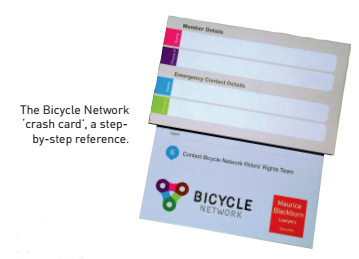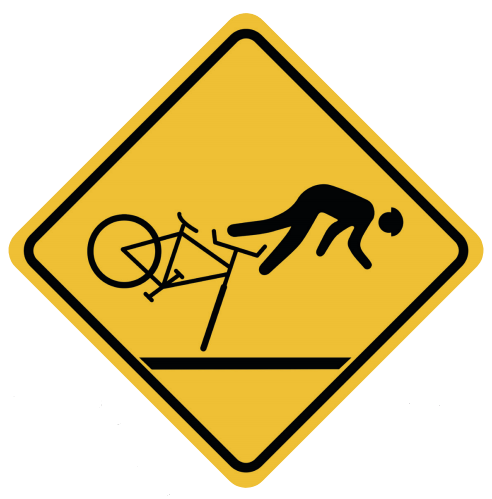Harriet Edmund advises what you need to do—and what you need to know—if you are involved in a crash.
You know the importance of staying vigilant while you ride into work but the road is greasy and nothing has prepared you for what’s about to happen. A motorist suddenly turns left, cutting in front of the bike lane. Bang!
You collide and drop to the bitumen. Hard. Adrenalin pumps through your body and shock threatens to overcome you.
So what comes next?
This is what many riders can be unsure about, says Jess Roberts, Members and Friends manager at Bicycle Network. In the moments following a crash, questions tend to arise messily: “Can I move? Is my bike okay? Did anyone see that? Should I call the police?”
There are also questions that need to be answered. “Can I claim from a compulsory third-party insurance? Will my contents insurance cover the damage? Do I need a lawyer?”
To help riders, Bicycle Network has devised a ‘crash card’—to be popped in your wallet, pannier or jersey—as a step-by-step reference of what to do after a crash.
“The card, available to all Bicycle Network members, aims to make sure riders know how to handle the situation so that you don’t miss collecting any key details,” says Roberts. “It also includes a place to record an emergency contact name and phone number.”

If you are involved in a crash, here are a few simple things that you should do.
BREATHE
The physiological response to trauma is an increase in adrenaline, says Professor George Braitberg, Director of Emergency Medicine at The Royal Melbourne Hospital. “The rise in adrenaline and other chemicals helps us manage pain and keeps us vigilant after an emotional or physical event, like crashing your bike.” Professor Braitberg suggests that the first thing you should do is take stock of the situation including your physical and mental state before even trying to move.
GET OUT OF DANGER
If you are able, get yourself to a safe area (off the road if that’s where you’ve landed) to avoid a secondary injury, says Braitberg. If you can’t move, stay still and wait for help. Call out for someone to help you and to ensure oncoming traffic is alerted of the hazard.
CHECK YOUR HELMET
If your helmet is damaged—irrespective of how you feel—you should always see a doctor, says Braitberg. Watch for symptoms of concussion such as loss of consciousness, confusion, headache, slurred speech, dizziness, nausea, vomiting or loss of memory and fatigue, which could happen at any time in the first 24 hours following a blow to the head.
EXCHANGE DETAILS
Regardless of who is at fault, if someone else is involved, you must exchange details. Sergeant Geoff Yeo of Victoria Police State Highway Patrol reminds us that “legislation states a person involved in a collision must give their name, address and the registration of the vehicle involved.” A quick way to do this is to use your phone to take a photo of the drivers’ licence and the number plate of the vehicle.
If there were witnesses, ask for their contact details but don’t worry about gathering their accounts of what happened as a lawyer will do so as required, advises Geraldine Collins, Maurice Blackburn road accident lawyer.
RECORD IT RIGHT
If possible, take photographs of the scene and record the details of what happened while they are fresh in your mind. Photographs should include where the bike and the vehicle came to rest (if there was one), the general scene including signage (or lack thereof), and road surface or obstacles (if these were contributing factors). Images of damage to your bike, clothing or gear will also help in a potential property damage claim. “The closer the photographs are taken to the time of the crash, the more valuable they are,” says Collins.
CONTACT THE POLICE
Do call the police when: anyone has been injured, if the collision is a hazard to other traffic, if there is ongoing danger to people or property, or if a driver appears to be under the influence of alcohol or drugs. Sergeant Yeo instructs in the instance when a police member did not attend the scene, you will need to attend a police station to report the matter in person. If the collision involved a motor vehicle—a car, motorbike, truck or public transport vehicle—you are eligible to claim from compulsory third-party insurance, if applicable in your state. To do this there must be a police report of the incident. Collins advises to acquire a copy of the police report for your personal records (this should cost approximately $50).
SEE A DOCTOR
Professor Braitberg has personal experience of feeling confused following a crash. A fall from his bicycle resulted in three broken ribs, a broken sternum and a collapsed lung. Rather than calling an ambulance immediately, he wrongly phoned his wife to pick him up. “I realised as soon as I got home that I was in trouble with pain and breathing,” he says. “I was very grateful when the paramedics showed up with some pain relief and took me straight to hospital.”
Braitberg advises to always seek a doctor if: there has been any damage to your helmet, with any lost consciousness or suspected concussion, when you feel persistent pain despite simple analgesics or if you have any difficulty breathing.
GET YOUR BIKE CHECKED
If your bike, equipment, clothing, helmet or backpack has been damaged, Collins suggests taking photographs and keeping the items in their current state until the incident has been resolved. “You need to get documentation proving the cost of the items that have been ruined, including quotes and receipts,” she says. “People have a perception that you need three quotes, but your requirement for a property damage claim is one.”
SEEK LEGAL ADVICE
There is a common misconception among riders that state statutory bodies, like the TAC in Victoria, will cover all bike crashes, says Jess Roberts. “Statutory insurance only covers riders when they are in a crash which involved the driving of a car (and in some cases trams or trains) but not single bike crashes, or bike-bike or bike-pedestrian crashes,” she explains. Doorings are covered, but colliding with a parked car usually is not, although if you are travelling to or from work, it can be. Because of these exceptions, riders may have to rely on personal injury, public liability and/or bike insurance.
Maurice Blackburn Lawyers offer free legal advice to Bicycle Network members, and Geraldine Collins recommends calling a lawyer as soon as possible. “It’s about finding out what your entitlements are”, she says. For example, under the TAC scheme, this could be anything from your medical expenses, to childcare and modifications to your home. “Broadly, these entitlements can exist for the rest of your life”.
You may also be covered for payment of wages due to injury sustained in the crash for three years and a lump sum payment if you have been left with a permanent impairment. In some circumstances, you may also have an entitlement for common law, explains Collins, where the individual is sued and the plaintiff receives payment for suffering the loss of enjoyment of life and/or for ongoing economic loss.
KNOW YOUR INSURANCE
If your crash does not involve a motor vehicle, you must rely on Medicare and private health insurance to cover medical costs and sick leave or private income protection if you’re off work, says Collins. Check whether your home and contents insurance includes public liability coverage, which may cover damage to an item outside of your property. Jess Roberts adds, “Bicycle Network membership includes both personal injury and public liability insurance, but we also recommend insurance such as Cycle-safe to cover your bike.”
TAKE IT TO COURT
If a state statutory body or your private insurance company is involved, your case is unlikely to end up in court, says Collins. “They are institutional insurers who understand the concepts of liability and what they are responsible for payment of,” she says. “If you’re disputing property damage, it depends upon what the liable person does. If they admit fault and lodge a claim with their insurance company, their insurer will deal with it. However, if the person isn’t insured or they refuse to lodge a claim, your action is against them personally.” The person may agree to pay for damages—usually in instalments—but if they refuse to engage at all, it may come before the Magistrates Court.
Ride On content is editorially independent, but is supported financially by members of Bicycle Network. If you enjoy our articles and want to support the future publication of high-quality content, please consider helping out by becoming a member.

